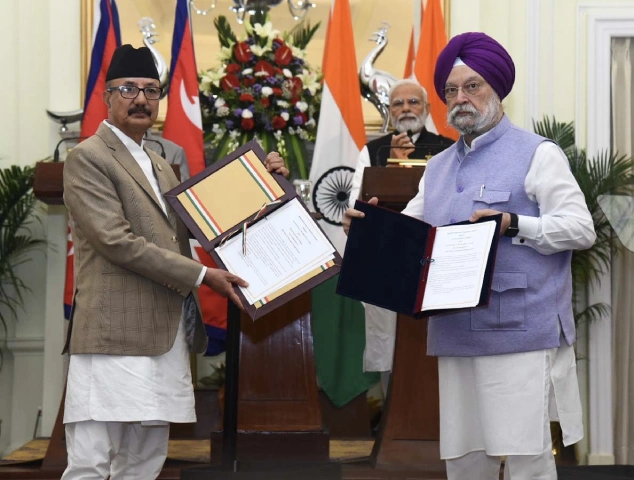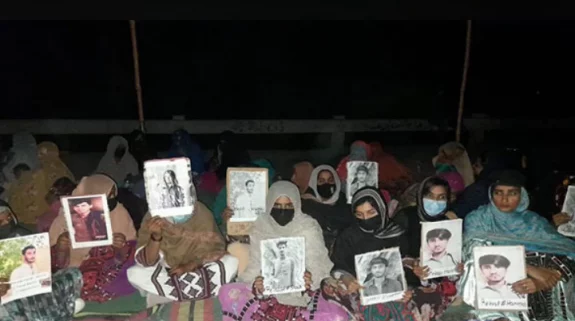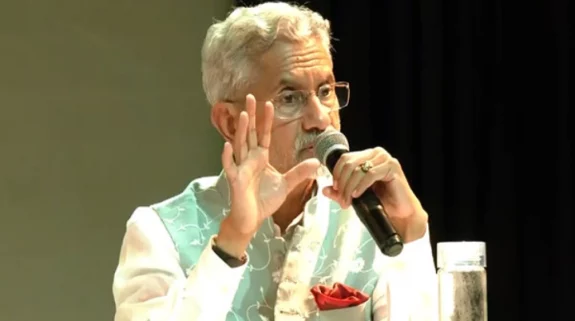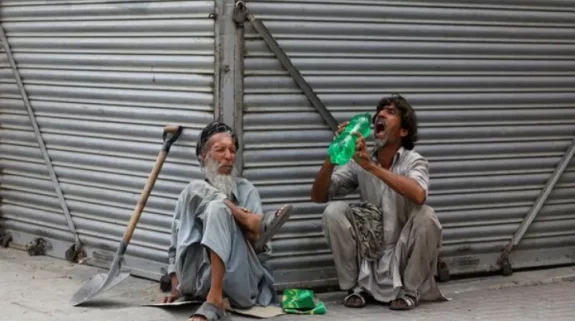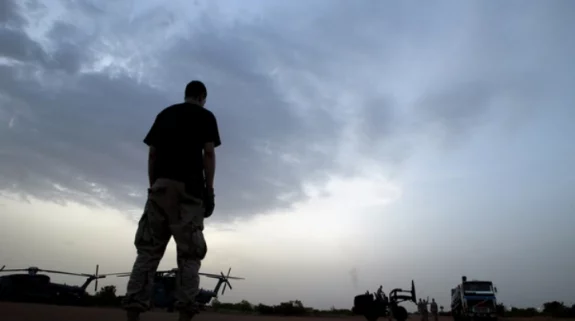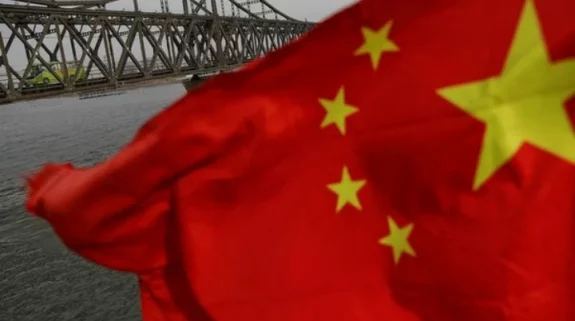Kathmandu: Nepal-India agreement on constructing an additional cross border petroleum pipeline and increasing Nepal’s oil storage capacity, would contribute to Nepal’s energy security, senior officials of Nepal Oil Corporation said.
The two countries signed a memorandum of understanding (MoU) for construction of a new cross border oil pipeline from Siliguri (West Bengal, India) to Jhapa, an eastern district of Nepal during Nepali Prime Minister Pushpa Kamal Dahal’s visit to India from May 31 to June 3.
As per the MoU, the two countries also agreed to extend the existing Motihari-Amlekhgunj Cross-Border Oil Pipeline to Chitwan from Amlekhgunj as well as construction of two greenfield terminals at Chitwan and Jhapa. Nepal Oil Corporation (NOC) officials said that most of the infrastructure would be built with Indian assistance.
“We need extra cross border oil pipeline as a contingency to possible damage to existing pipeline due to unforeseen reasons,” Birendra Goit, deputy managing director of Nepal Oil Corporation (NOC), the state-owned oil monopoly, told India Narrative. “The two greenfield terminals at Chitwan and Jhapa will boost Nepal’s oil storage capacity which is also very important from the perspective of energy security.”
The NOC said it currently has an authorised energy depot with a working storage capacity of 68,384 kiloliters only which can sustain the oil demands for just five days.
Nepal is currently constructing five storage tanks with a combined capacity of 28,000kl— one with 10,000kl capacity in western Pokhara city and four storage tanks with combined capacity of 18.000kl at Amlekhgunj, according to NOC.
“Of four storage tanks being built at Amlekhgunj, two tanks with capacity of 4,100kl each are being built by Indian Oil Corporation for storing petrol while two others with capacity of 5000kl each, are being built by the NOC for storing petrol and diesel each,” said Binitmani Upadhyay, chief of Madhes Provincial Office of NOC at Amlekhgunj. “They are expected to be completed by the end of 2023.”
As per the latest MoU on petroleum pipeline, two greenfield terminals- to be built at Chitwan and Jhapa will increase Nepal’s oil storage capacity further. “One greenfield oil storage terminal to be built at Chitwan will have the capacity of 100,000kl while another terminal to be built in Jhapa will have the capacity of 42,000kl,” Goit said. “After all these storage projects are built, we will have storage capacity to sustain the fuel demand for 20 days.”
Nepal earlier had announced that it would increase the oil storage capacity to sustain the demand for three months. Such announcement was made after the country faced fuel scarcity for a few months when Nepal faced border blockade from Madhesi protestors in 2015 with an alleged backing of India ahead of promulgation of new constitution of Nepal.
In August 2015, the two neighbours had signed a memorandum of understanding to build South Asia’s first petroleum pipeline project from India’s Motihari to Amalekhgunj in Nepal. The project was inaugurated in September 2019 when the then Nepali Prime Minister KP Sharma Oli visited India.
Nepal has been receiving diesel through the 69-kilometre-long pipeline whose 36-kilometre section lies on Nepali territory.
After increasing the storage capacity, the NOC also has plans to take supply of petrol and kerosene through the pipeline. Currently, it has been taking supply of diesel only through the pipeline. “It is because of limited storage capacity,” said Upadhyay. Diesel is the largest petroleum product being imported by Nepal.
NOC officials said that additional cross border pipeline and extension of existing pipeline to Lothar, Chitwan in Nepal would help to reduce supply cost of oil and help reduce air pollution as well in the country.
“Since the Motihari-Amlekhgunj pipeline came into operation, we are saving around Rs1.5 billion a year in transportation cost alone,” said Upadhyay.
However, environmentalists have questioned the need for new oil pipeline infrastructure in the country at a time when Nepal has already made its commitment to become a net zero emitter by 2045.
In November 2021, Nepal’s Former Prime Minister Sher Bahadur Deuba had made Nepal’s commitment to achieve this target by increasing the share of clean energy in the country’s energy demand to 15 per cent by 2030 during the 26th Conference of Parties (COP26) of the UN Framework Convention on Climate Change in Glasgow, Scotland.
Bhusan Tuladhar, an environmentalist, told the India Narrative that development of such infrastructure would encourage the government to prolong Nepal’s dependence on oil.
“We should have invested more on developing electricity infrastructure instead of oil pipelines in the context of Nepal’s commitment to achieve net zero emission and electric vehicle penetration targets,” he said.
According to Nepal’s nationally determined contribution released in 2020, the sales of electric vehicles (e-vehicles) in 2025 will be 25 percent of all private passenger vehicles sales, including two-wheelers and 20 percent of all four-wheeler public passenger vehicle sales.
By 2030, e-vehicles will cover 90 percent of all private passenger vehicle sales, including two-wheelers and 60 percent of all four-wheeler public passenger vehicle sales, according to the Nationally Determined Contribution.
By 2030, Nepal will ensure 15 percent of the total energy demand is supplied from clean energy sources. In 2021, the share of clean energy including electricity and renewables stood at just 6.4 percent of total energy consumption in Nepal, according to Nepal Energy Sector Synopsis Report 2022.
Tuladhar said construction of the oil pipeline would benefit the country temporarily with reduced cost, reduced pollution and recovery of investment as well. “But will it be beneficial in the long run when people will increasingly buy electric vehicles as prices of electric vehicles are expected to lower to the level of fuel-based vehicles in the next five years,” he asked.
However, NOC officials say as electricity would not be replacing fuel at all levels for the next several years and investment being made in oil pipelines won’t go into waste. “In India, which has lately focussed on clean energy and electric vehicles, has also been adding new oil refineries and increasing their capacities,” said Goit. “This suggests that fuel
Nepal imported petroleum products worth nearly NPR 1 trillion in the fiscal year 2021-22 that ended in mid-July last year as petroleum products continue to remain as the largest import items of Nepal, according to Trade and Export Promotion Centre, an agency under Nepal’s Commerce Ministry.
Supply of petroleum products through the pipeline is considered the cheapest mode of oil supply. Then, fuel supply through freight trains is considered relatively expensive while supply through tankers is considered the most expensive mode of supply. Until the first cross-border pipeline came into operation in 2019, Nepal was fully reliant on supply of fuel through the tankers.
“They used to cause traffic jams and incidents of fuel adulteration were also high,” said Goit. “With a petroleum pipeline, fuel supply is guaranteed even when there is a general strike.”
Also Read: Are India and Sri Lanka turning Trincomalee into major energy and industrial hub of South Asia?
(Prithvi Shreshtha writes for India Narrative from his perch in Kathmandu)






